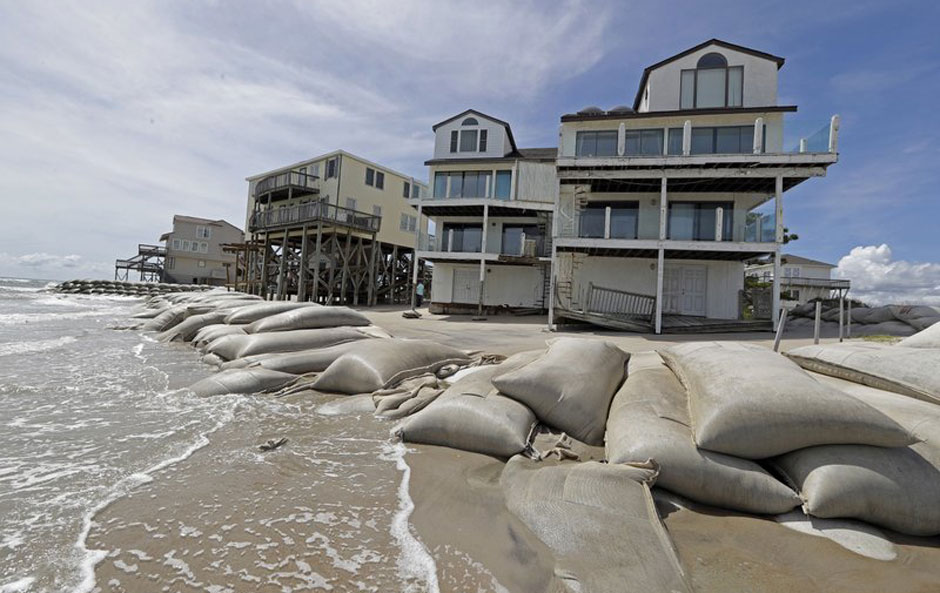
MYRTLE BEACH, S.C. — The outer bands of wind and rain from Hurricane Florence began lashing North Carolina on Thursday as the monster storm moved in for an extended stay along the Southeastern coast, promising to drench the properties of 10 million people with immense amounts of water.
Florence’s top sustained wind speeds dropped from a high of 140 mph (225 kph) to 110 mph (175 kph) as its outer rain bands approached the North Carolina coast early Thursday. That reduced the winds’ destructive power from Category 4 to Category 2, but forecasters warned that the widening storm, and its likelihood of lingering along the coast day after day after day, raises the risk of surging ocean water and torrential rain.
“For a meandering storm, the biggest concern — as we saw with Harvey — is the huge amount of rainfall,” said Chris Landsea, chief of tropical analysis and forecast branch at the National Hurricane Center.
As the first bands reached the shores of the U.S., rather than take charge of the federal response, President Trump began tweeting claims that the now-official death toll of 2,975 killed by Hurricane Maria in Puerto Rico “is a hoax.” He said that many of those listed as “killed” simply died of “old age.
“3,000 people did not die in the two hurricanes that hit Puerto Rico,” the president tweeted this morning. “When I left the island, AFTER the storm had hit, they had anywhere from six to 16 deaths. As time went by it did not go up by much. Then a long time later they started to report really large numbers, like 3,000.
“This was done by the Democrats in order to make me look as bad as possible when I was successfully raising billions of dollars to help rebuild Puerto Rico. If a person died for any reason, like old age, just add them on the list. Bad politics. I love Puerto Rico.”
Thousands who died from pre-existing conditions and old age were in fact not included on the list of post-hurricane deaths and there have been no reports of Trump having raised any funds at all for the recovery. Millions watched on TV as he threw paper towels at victims who needed water, food and medicine but no one has seen any fundraising efforts by the president. The American people, however, have sent millions of dollars in aid which has been acknowledged by the Puerto Rican government.
While he was tweeting the monster storm Florence was centered about 170 miles (275 kilometers) east-southeast of Wilmington, North Carolina and about 220 miles (355 kilometers) east-southeast of Myrtle Beach, South Carolina, moving northwest at 12 mph (20 kph). Hurricane-force winds were blowing 80 miles (130 kilometers) from its center, and tropical-storm-force winds reached up to 195 miles (315 kilometers) from the eye.
The hurricane center’s best guess was that Florence’s eye would blow ashore as early as Friday afternoon around the North Carolina-South Carolina line. Then, it will likely hover along the coast Saturday, pushing up to 13 feet (nearly 4 meters) of storm surge and dumping 20 to 30 inches (50 to 75 centimeters) of rain on both states, before slogging over the Appalachian Mountains.
The result: catastrophic inland flooding that could swamp homes, businesses, farm fields and industrial sites.
About 5.25 million people live in areas under hurricane warnings or watches, and 4.9 million more live in places covered by tropical storm warnings or watches, the National Weather Service said.
Weather Underground meteorology director Jeff Masters said Florence eventually could strike as a Category 1 with winds less than 100 mph (160 kph), but that’s still enough to cause at least $1 billion in damage. Water kills more people in hurricanes than wind, and the rain and storm surge will make Florence extremely dangerous.
It’s unclear exactly how many people fled, but more than 1.7 million people in the Carolinas and Virginia were warned to clear out. Airlines canceled nearly 1,000 flights and counting. Home Depot and Lowe’s activated emergency response centers to get generators, trash bags and bottled water to stores before and after the storm. The two hardware chains said they sent in a total of around 1,100 trucks.
Duke Energy, the nation’s No. 2 power company, said Florence could knock out electricityto three-quarters of its 4 million customers in the Carolinas, and outages could last for weeks. Workers are being brought in from the Midwest and Florida to help in the storm’s aftermath, it said.
Boarding up his home in Myrtle Beach, South Carolina, Chris Pennington watched the forecasts and tried to decide when to leave.
“In 12 or 18 hours, they may be saying different things all over again,” he said.
Computer models of exactly what the storm might do varied, adding to the uncertainty. Reacting to the possibility of a more southerly track, Georgia Gov. Nathan Deal declared an emergency but did not immediately order any evacuations.
“I ask all Georgians to join me in praying for the safety of our people and all those in the path of Hurricane Florence,” Deal said.
In Virginia, where about 245,000 residents were ordered to evacuate low-lying areas, officials urged them to stay in safer locations despite forecast changes showing Florence’s path largely missing the state.

With their entire neighborhood evacuated in Wilmington, North Carolina, David and Janelle Garrigus planned to ride out Florence at their daughter’s one-bedroom apartment in Charlotte. Unsure of what they might find when they return home, the couple went shopping for a recreational vehicle.
“We’re just trying to plan for the future here, not having a house for an extended period of time,” David Garrigus said.
Melody Rawson evacuated her first-floor apartment in Myrtle Beach and arrived at Atlanta Motor Speedway in Hampton, Georgia, to camp for free with three other adults, her disabled son, two dogs and a pet bird.
“We hope to have something left when we get home,” she said. Three other Southern raceways also opened campgrounds to evacuees.
Forecasters worried the storm’s damage will be all the worse if it lingers on the coast. The trend is “exceptionally bad news,” said University of Miami hurricane researcher Brian McNoldy, since it “smears a landfall out over hundreds of miles of coastline, most notably the storm surge.”
With South Carolina’s beach towns now more in the bulls-eye because of the shifting forecast, Ohio vacationers Chris and Nicole Roland put off their departure from North Myrtle Beach to get the maximum amount of time on the sand. Most other beachgoers were long gone.
“It’s been really nice,” Nicole Roland said. “Also, a little creepy. You feel like you should have already left.”
____
Associated Press writers Seth Borenstein in Washington; Jonathan Drew in Wilmington, North Carolina; Jennifer Kay in Miami; Gary Robertson in Raleigh, North Carolina; Sarah Rankin and Denise Lavoie in Richmond, Virginia; Meg Kinnard in Columbia, South Carolina; Skip Foreman in Charlotte, North Carolina; Jeff Martin in Hampton, Georgia; David Koeing in Dallas; and Jay Reeves in Atlanta contributed to this report.













Comments